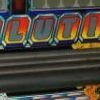BBC model B uses the same ram chips, clues here ??
http://www.amibay.com/showthread.php?19309-HM4816-RAM-Chips-for-Acorn-BBC
http://mdfs.net/Info/Comp/BBC/Circuits/BBC/bbc.gif
<Display>
Perhaps the cleverest part of the entire BBC Micro’s circuit is the way that the 6845 CRTC is used. If you look at an application sheet for the 6845 you will see that it is supposed to access two different types of memory. An area of RAM, used to store ASCII codes and an area of ROM to generate the dot patterns of the characters to be displayed. The idea is that the output of the RAM is used to select a dot pattern from the ROM and the CRIC provides extra addressing to select each byte of data which make up the characters. Of course the BBC Micro (in modes 0 to 6) doesn’t use a ROM to generate the dot patterns as they are stored directly in RAM. Another interesting feature is the way that the 6845 is coaxed into providing colour information – the raw 6845 is a monochrome device. The key to understanding how the 6845 has been used in the BBC Micro is to notice that although its address lines are segregated into two groups – MA0 to MA13 and RA0 to RA2 – they can just as easily be used to address a single block of memory. In other words, the CRTC simply addresses the memory a certain number of times per TV scan line and what happens to the data that is produced is not its concern.
Once the data has been selected by the CRTC it is sent (a byte at a time) to the video ULA (IC6) where it is serialised and applied as the address to a small area of static RAM – the palette RAM. This is responsible for adding the colour to the display. The output of the palette RAM is a four bit word indicating the state of the R(ed), G(reen), B(lue) and Flash signals. The RGB signal is fed (via Q4 to Q6) to the RGB monitor connector and to the PAL colour encoder formed by Q10, IC46, IC47, IC48, Q8 and Q9. The PAL signal is finally applied to a standard ASTEC UHF modulator and brought out through a phono socket. A composite monochrome video signal is also provided by Q7 and Q8 for monochrome monitors. Notice that all the TV sync signals are generated by the CRTC. The cursor signal is mixed into the video signal by the video ULA.



